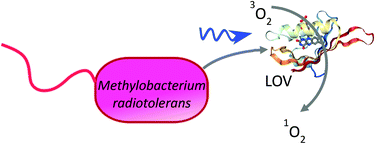Single mutation in a novel bacterial LOV protein yields a singlet oxygen generator†
Abstract
Mr4511 from Methylobacterium radiotolerans is a 164 amino acid protein built of a flavin mononucleotide (FMN) binding, blue-light responsive LOV (Light, Oxygen, Voltage) core domain plus flanking regions. In contrast to the majority of LOV domains, Mr4511 lacks a tryptophan residue that was previously identified as a major quencher for the FMN triplet state in photosensitizers for singlet oxygen (SO) engineered from these photoreceptors. Here we show that for Mr4511 it is sufficient to only mutate the reactive cysteine responsible for the photocycle (Cys71) in the native protein to generate an efficient SO photosensitizer: both C71S and C71G variants exhibit SO quantum yields of formation, ΦΔ, around 0.2 in air-saturated solutions. Under oxygen saturated conditions, ΦΔ reaches ∼0.5 in deuterated buffer. The introduction of Trp112 in the canonical position for LOV domains dramatically lowers ΦΔ to values comparable to miniSOG, one of the early FMN binding proteins touted as a SO sensitizer. Besides its SO properties, Mr4511 is also exceedingly robust against denaturation with urea and is more photostable than free FMN.



 Please wait while we load your content...
Please wait while we load your content...